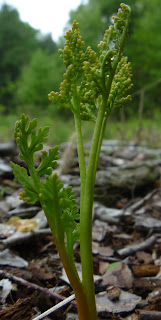
Welcome to Ohio Flora
Wednesday, June 29, 2011
Monday, June 13, 2011
Thursday, May 26, 2011
Ohio's Viola Species
 |
| Viola rostrata - Long-spurred Violet |
 |
| Viola lanceolata - Lance-leaved Violet |
I wanted to pass along the link to my personal nature/botany blog for a recent post I published about the Viola species Ohio has to offer. It's way too large and detailed a post to repeat on here so I figured I'd just go the easy route and link into the Ohio Flora blog. That way this blog has a healthy violet addition! Hope you all check it out and enjoy! There's over 20 species to be had on this post with I.D. characteristics, photographs and life history.
The Natural Treasures of Ohio - The Violets of Ohio Thanks for tuning in!
 |
| Viola sagittata - Arrow-leaved Violet |
Thursday, May 19, 2011
Butterweed, Packera glabella
 |
| Crop field in Delaware County, Ohio |
It's all over central and western Ohio, but by looking at this map, you'd think it was a rarity. It's even showing up in my front yard as a weed! Why has this plant expanded so rapidly? Is it taking advantage of no-till agriculture? Is there something else to the story? I'm not sure, but I bet that it grows in every county in Ohio's corn belt plains, and on this map, it barely registers in a few Ohio counties.
Plants get around- they move, and they can do things that we never expect. And that's why I think they're incredibly cool. Look out Pennsylvania, butterweed may be headed towards you!
Tom
p.s. (I bet it's probably there already)
Friday, May 13, 2011
Crossvine, Bignonia capreolata
Let's try this one again, this time with the pictures!
Let's try this one again, this time with the pictures!
Before this year's Flora-quest, I had only seen crossvine growing on the limestone walls of the Governor's Residence. We had an little extra time at the end of our Flora-quest, and Amy Fitton suggested that we take our group to see it growing in the wild. She didn't know exactly how far down the road it would be, but when I came to a rock outcropping on the right, she explained, that's where it would be. Sure enough, she was spot on, and our group had excellent opportunities to see this native vine that reaches its northern limits in extreme southern Ohio.
Tom
Let's try this one again, this time with the pictures!
Before this year's Flora-quest, I had only seen crossvine growing on the limestone walls of the Governor's Residence. We had an little extra time at the end of our Flora-quest, and Amy Fitton suggested that we take our group to see it growing in the wild. She didn't know exactly how far down the road it would be, but when I came to a rock outcropping on the right, she explained, that's where it would be. Sure enough, she was spot on, and our group had excellent opportunities to see this native vine that reaches its northern limits in extreme southern Ohio.
Tom
Thursday, May 5, 2011
Nodding Mandarin - Prosartes maculata
 |
| May 1, 2011 - Adams County |
 |
| May 1, 2011 - Adams County |
 |
| May 1, 2011 - Adams County |
 |
| May 1, 2011 - Adams County |
There is nothing else like this plant out there when in bloom. Their blooming time is very short and during a time where it's easy to overlook due to how much other wildflower activity is going on. If you ever get the chance to lay eyes on this plants flower consider yourself very lucky due to its rarity, local distribution and the beautiful show it puts on in mid to late April.
Labels:
liliaceae,
Nodding Mandarin,
Prosartes maculata
Sunday, May 1, 2011
Goldenseal - Hydrastis canadensis
 A close examination of the Goldenseal flower shows a complete lack of petals. The bloom consists of a ring of stamens surrounding a central cluster of pistils.
A close examination of the Goldenseal flower shows a complete lack of petals. The bloom consists of a ring of stamens surrounding a central cluster of pistils. The flower bud is protected by three sepals which are shed as the flower opens. Many people imagine the stamens to be petals and are led astray in their attempts to properly identify this plant.
The flower bud is protected by three sepals which are shed as the flower opens. Many people imagine the stamens to be petals and are led astray in their attempts to properly identify this plant. Flowering plants develop an elongated stem with a pair of alternately placed leaves. The lower leaf is the larger of the two.
Flowering plants develop an elongated stem with a pair of alternately placed leaves. The lower leaf is the larger of the two. A single bloom is located at the top of the stem.
A single bloom is located at the top of the stem. Non-flowering specimens have a single leaf at the top of the stem. People often mistake the non-flowering plants as being May-apples.
Non-flowering specimens have a single leaf at the top of the stem. People often mistake the non-flowering plants as being May-apples. Look for this plant in upland woods with deep soils. Many Goldenseal populations have been decimated by people collecting the plant for its supposed medicinal properties. The plant contains a variety of different alkaloids and is considered toxic.
Look for this plant in upland woods with deep soils. Many Goldenseal populations have been decimated by people collecting the plant for its supposed medicinal properties. The plant contains a variety of different alkaloids and is considered toxic.Photos taken on April 30, 2011 in Adams County, Ohio.
Labels:
Goldenseal,
Hydrastis canadensis,
Ranunculaceae
Subscribe to:
Posts (Atom)






